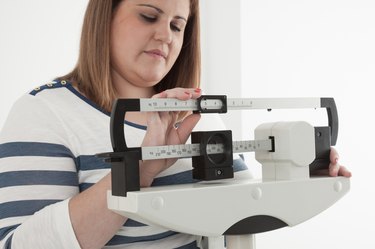
In a weight-loss contest, people who have obesity have an advantage over those who have a lower weight because they shed fat more quickly. This is why contests, such as "The Biggest Loser," use weight-loss percentage to track progress rather than simply counting the lost pounds.
Weight Loss Principles
Video of the Day
People lose weight by decreasing the number of calories they eat and by increasing how many calories they burn by exercising. For every 3,500 calories you burn through activity and don't use for energy, you lose approximately 1 pound of fat. This means that creating a 1,000-calorie deficit each day results in a loss of 2 pounds per week.
Video of the Day
Sedentary Lifestyle
A lack of physical activity can contribute to the risk of gaining weight, but can also contribute to a continued disinclination to be physically active. Even a modest amount of exercise can represent a significant increase in activity and calorie burn.
Mass
The more someone weighs, the more calories that person burns in activity. They have greater mass to propel, so it requires more energy to move that mass. A 150-pound person burns about 236 calories walking at 3 mph for 60 minutes; it would take them more than two weeks of daily hour-long walks to burn off 1 pound. A 250-pound person burns 393 calories in 60 minutes of walking at 3 mph, so they would burn off 1.7 pounds in the same time period. Of course, they would have worked harder at it, because they had more weight to move around.
Higher Basal Metabolism
Your basal metabolic rate, or BMR, is the number of calories you burn maintaining the operations of your body over the course of the day while at rest. Even when you are inactive, your body burns calories running your brain, lungs, heart, kidneys and other organs, and it also uses energy repairing and replacing cells and tissues. Bigger bodies have higher maintenance costs. The more you weigh the more calories you burn, even when you are inactive. A 5-foot, 8-inch tall, 40-year-old female who weighs 150 pounds has a BMR of 1,433 calories, estimates the calorie calculator on MyPlate. Her 250-pound counterpart has a BMR of 1,863 calories, a 430-calorie difference. If they were both placed on the same calorie-restricted diet, the heavier woman would have a greater calorie deficit between what she ate and what she needed to maintain her weight. The heavier woman could lose as much as 1 pound more every eight days because of her greater metabolism.
- ExRx.net: Estimated Calorie Requirements
- ExRx.net: Walk / Run Metabolic Calculator
- Medicine & Science in Sports & Exercise: Contribution of a Sedentary Lifestyle and Inactivity to the Etiology of Overweight and Obesity: Current Evidence and Research Issues
- Obesity: Prospective Associations Between Sedentary Lifestyle and BMI
- Harvard Health Publications: Calorie Counting Made Easy